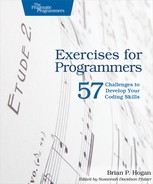Driving Design with Tests
One of the best ways to design and develop software is to think about the result you want to get right from the start. Many professional software developers do this using a formal process called test-driven development, or TDD. In TDD, you write bits of code that test the outputs of your program or the outputs of the individual programs that make up a larger program. This process of testing as you go guides you toward good design and helps you think about the issues your program might have.
TDD does require some knowledge about the language you’re using and a little more experience than the beginning developer has out of the gate.
However, the essence of TDD is to think about what the expected result of the program is ahead of time and then work toward getting there. And if you do that before you write code, it’ll make you think beyond what the initial requirements say. So if you’re not quite comfortable doing formal TDD, you can still get many of the benefits by creating simple test plans. A test plan lists the program’s inputs and its expected result.
Here’s what a test plan looks like:
| | Inputs: |
| | Expected result: |
| | Actual result: |
You list the program inputs and then write out what the program’s output should be. And then you run your program and compare the expected result with the actual result your program gives out.
Let’s put this into practice by thinking about our tip calculator. How will we know what the program’s output should be? How will we know if we calculate it correctly?
Well, let’s define how we want things to work by using some test plans. We’ll do a very simple test plan first.
| | Inputs: |
| | bill amount: 10 |
| | tip rate: 15 |
| | Expected result: |
| | Tip: $1.50 |
| | Total: $11.50 |
That test plan tells us a couple things. First, it tells us that we’ll take in two inputs: a bill amount of 10 and a tip rate of 15. So we’ll need to handle converting the tip rate from a whole number to a decimal when we do the math. It also tells us we’ll print out the tip and total formatted as currency. So we know that we’d better do some conversions in our program.
Now, one test isn’t enough. What if we used 11.25 as an input? Using a test plan, what should the output be? Try it out. Fill in the following plan:
| | Input: |
| | bill amount: 11.25 |
| | tip rate: 15 |
| | Expected result: |
| | Tip: ??? |
| | Total: ??? |
I assume you just went and used a calculator to figure out the tip. If you ran the calculation, your calculator probably said the tip should be 1.6875.
But is that realistic? Probably not. We would probably round up to the nearest cent. So our test plan would look like this:
| | Input: |
| | bill amount: 11.25 |
| | tip rate: 15 |
| | Expected result: |
| | Tip: $1.69 |
| | Total: $12.94 |
We just used a test to design the functionality of our program; we determined that our program will need to round up the answer.
When you’re going through the exercises in this book, take the time to develop at least four test plans for every program, and try to think of as many scenarios as you can for how people might break the program. And as you get into the more complicated problems, you may need a lot more test plans.
If you’re an experienced software developer who wants to get started with TDD, you should use the exercises in this book to get acquainted with the libraries and tools your favorite language has to offer. You can find a list of testing frameworks for many programming languages at Wikipedia.[2] You can read Kent Beck’s Test-Driven Development: By Example to gain more insight into how to design code with tests, or you can investigate any number of more language-specific resources on TDD.
So now that we have a clearer picture of the features the program will have, we can start putting together the algorithm for the program.
